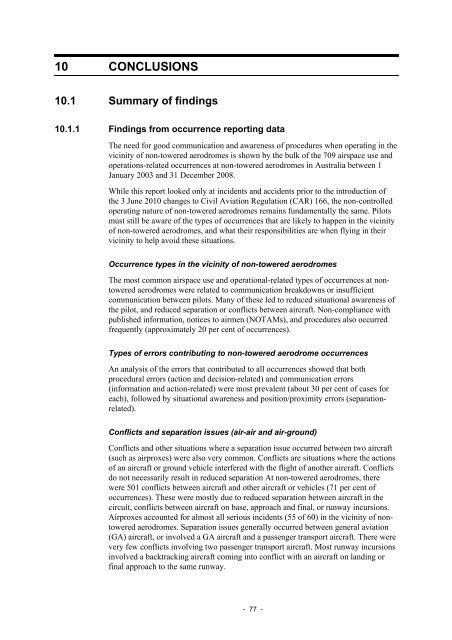Safety in the vicinity of non-towered aerodromes - Australian ...
Safety in the vicinity of non-towered aerodromes - Australian ...
Safety in the vicinity of non-towered aerodromes - Australian ...
You also want an ePaper? Increase the reach of your titles
YUMPU automatically turns print PDFs into web optimized ePapers that Google loves.
10 CONCLUSIONS<br />
10.1 Summary <strong>of</strong> f<strong>in</strong>d<strong>in</strong>gs<br />
10.1.1 F<strong>in</strong>d<strong>in</strong>gs from occurrence report<strong>in</strong>g data<br />
The need for good communication and awareness <strong>of</strong> procedures when operat<strong>in</strong>g <strong>in</strong> <strong>the</strong><br />
vic<strong>in</strong>ity <strong>of</strong> <strong>non</strong>-<strong>towered</strong> <strong>aerodromes</strong> is shown by <strong>the</strong> bulk <strong>of</strong> <strong>the</strong> 709 airspace use and<br />
operations-related occurrences at <strong>non</strong>-<strong>towered</strong> <strong>aerodromes</strong> <strong>in</strong> Australia between 1<br />
January 2003 and 31 December 2008.<br />
While this report looked only at <strong>in</strong>cidents and accidents prior to <strong>the</strong> <strong>in</strong>troduction <strong>of</strong><br />
<strong>the</strong> 3 June 2010 changes to Civil Aviation Regulation (CAR) 166, <strong>the</strong> <strong>non</strong>-controlled<br />
operat<strong>in</strong>g nature <strong>of</strong> <strong>non</strong>-<strong>towered</strong> <strong>aerodromes</strong> rema<strong>in</strong>s fundamentally <strong>the</strong> same. Pilots<br />
must still be aware <strong>of</strong> <strong>the</strong> types <strong>of</strong> occurrences that are likely to happen <strong>in</strong> <strong>the</strong> vic<strong>in</strong>ity<br />
<strong>of</strong> <strong>non</strong>-<strong>towered</strong> <strong>aerodromes</strong>, and what <strong>the</strong>ir responsibilities are when fly<strong>in</strong>g <strong>in</strong> <strong>the</strong>ir<br />
vic<strong>in</strong>ity to help avoid <strong>the</strong>se situations.<br />
Occurrence types <strong>in</strong> <strong>the</strong> vic<strong>in</strong>ity <strong>of</strong> <strong>non</strong>-<strong>towered</strong> <strong>aerodromes</strong><br />
The most common airspace use and operational-related types <strong>of</strong> occurrences at <strong>non</strong><strong>towered</strong><br />
<strong>aerodromes</strong> were related to communication breakdowns or <strong>in</strong>sufficient<br />
communication between pilots. Many <strong>of</strong> <strong>the</strong>se led to reduced situational awareness <strong>of</strong><br />
<strong>the</strong> pilot, and reduced separation or conflicts between aircraft. Non-compliance with<br />
published <strong>in</strong>formation, notices to airmen (NOTAMs), and procedures also occurred<br />
frequently (approximately 20 per cent <strong>of</strong> occurrences).<br />
Types <strong>of</strong> errors contribut<strong>in</strong>g to <strong>non</strong>-<strong>towered</strong> aerodrome occurrences<br />
An analysis <strong>of</strong> <strong>the</strong> errors that contributed to all occurrences showed that both<br />
procedural errors (action and decision-related) and communication errors<br />
(<strong>in</strong>formation and action-related) were most prevalent (about 30 per cent <strong>of</strong> cases for<br />
each), followed by situational awareness and position/proximity errors (separationrelated).<br />
Conflicts and separation issues (air-air and air-ground)<br />
Conflicts and o<strong>the</strong>r situations where a separation issue occurred between two aircraft<br />
(such as airproxes) were also very common. Conflicts are situations where <strong>the</strong> actions<br />
<strong>of</strong> an aircraft or ground vehicle <strong>in</strong>terfered with <strong>the</strong> flight <strong>of</strong> ano<strong>the</strong>r aircraft. Conflicts<br />
do not necessarily result <strong>in</strong> reduced separation At <strong>non</strong>-<strong>towered</strong> <strong>aerodromes</strong>, <strong>the</strong>re<br />
were 501 conflicts between aircraft and o<strong>the</strong>r aircraft or vehicles (71 per cent <strong>of</strong><br />
occurrences). These were mostly due to reduced separation between aircraft <strong>in</strong> <strong>the</strong><br />
circuit, conflicts between aircraft on base, approach and f<strong>in</strong>al, or runway <strong>in</strong>cursions.<br />
Airproxes accounted for almost all serious <strong>in</strong>cidents (55 <strong>of</strong> 60) <strong>in</strong> <strong>the</strong> vic<strong>in</strong>ity <strong>of</strong> <strong>non</strong><strong>towered</strong><br />
<strong>aerodromes</strong>. Separation issues generally occurred between general aviation<br />
(GA) aircraft, or <strong>in</strong>volved a GA aircraft and a passenger transport aircraft. There were<br />
very few conflicts <strong>in</strong>volv<strong>in</strong>g two passenger transport aircraft. Most runway <strong>in</strong>cursions<br />
<strong>in</strong>volved a backtrack<strong>in</strong>g aircraft com<strong>in</strong>g <strong>in</strong>to conflict with an aircraft on land<strong>in</strong>g or<br />
f<strong>in</strong>al approach to <strong>the</strong> same runway.<br />
- 77 -
















